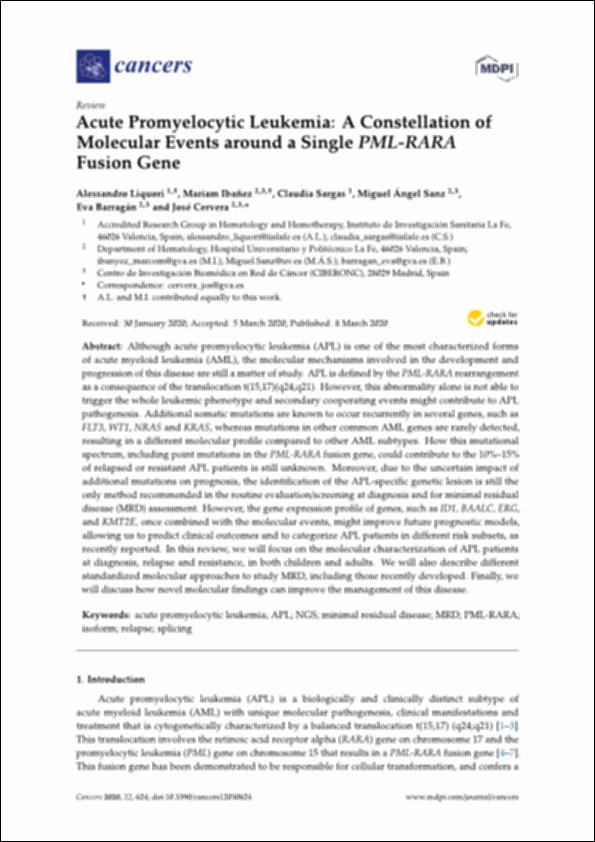Por favor, use este identificador para citar o enlazar este ítem:
http://hdl.handle.net/10637/12433Acute promyelocytic leukemia : a constellation of molecular events around a single PML-RARA fusion gene
| Título : | Acute promyelocytic leukemia : a constellation of molecular events around a single PML-RARA fusion gene |
| Autor : | Liquori, Alessandro Ibáñez Company, Mariam Sargas Simarro, Claudia Sanz Alonso, Miguel Ángel Barragán González, Eva Cervera Zamora, José Vicente |
| Materias: | Biología molecular.; Molecular biology.; Acute promyelocytic leukemia - Molecular aspects.; Leucemia promielocítica aguda - Aspectos moleculares.; Cancer cells - Molecular aspects.; Células cancerosas - Aspectos moleculares. |
| Editorial : | MDPI |
| Citación : | Liquori, A., Ibañez, M., Sargas, C., Sanz, M. Á., Barragán, E., & Cervera, J. (2020). Acute Promyelocytic Leukemia: A Constellation of Molecular Events around a Single PML-RARA Fusion Gene. Cancers, vol. 12, i. 3 (08 mar. 2020), art. 624. DOI: http://dx.doi.org/10.3390/cancers12030624 |
| Resumen : | Although acute promyelocytic leukemia (APL) is one of the most characterized forms of acute myeloid leukemia (AML), the molecular mechanisms involved in the development and progression of this disease are still a matter of study. APL is defined by the PML-RARA rearrangement as a consequence of the translocation t(15;17)(q24;q21). However, this abnormality alone is not able to trigger the whole leukemic phenotype and secondary cooperating events might contribute to APL pathogenesis. Additional somatic mutations are known to occur recurrently in several genes, such as FLT3, WT1, NRAS and KRAS, whereas mutations in other common AML genes are rarely detected, resulting in a di erent molecular profile compared to other AML subtypes. How this mutational spectrum, including point mutations in the PML-RARA fusion gene, could contribute to the 10%–15% of relapsed or resistant APL patients is still unknown. Moreover, due to the uncertain impact of additional mutations on prognosis, the identification of the APL-specific genetic lesion is still the only method recommended in the routine evaluation/screening at diagnosis and for minimal residual disease (MRD) assessment. However, the gene expression profile of genes, such as ID1, BAALC, ERG, and KMT2E, once combined with the molecular events, might improve future prognostic models, allowing us to predict clinical outcomes and to categorize APL patients in di erent risk subsets, as recently reported. In this review, we will focus on the molecular characterization of APL patients at diagnosis, relapse and resistance, in both children and adults. We will also describe di erent standardized molecular approaches to study MRD, including those recently developed. Finally, we will discuss how novel molecular findings can improve the management of this disease. |
| Descripción : | Este artículo se encuentra disponible en la siguiente URL: https://www.mdpi.com/2072-6694/12/3/624 Este artículo pertenece al número especial "Acute Promyelocytic Leukemia". |
| URI : | http://hdl.handle.net/10637/12433 |
| Derechos: | http://creativecommons.org/licenses/by/4.0/deed.es |
| ISSN : | 2072-6694 (Electrónico). |
| Fecha de publicación : | 8-mar-2020 |
| Centro : | Universidad Cardenal Herrera-CEU |
| Aparece en las colecciones: | Dpto. Ciencias Biomédicas |
Los ítems de DSpace están protegidos por copyright, con todos los derechos reservados, a menos que se indique lo contrario.


